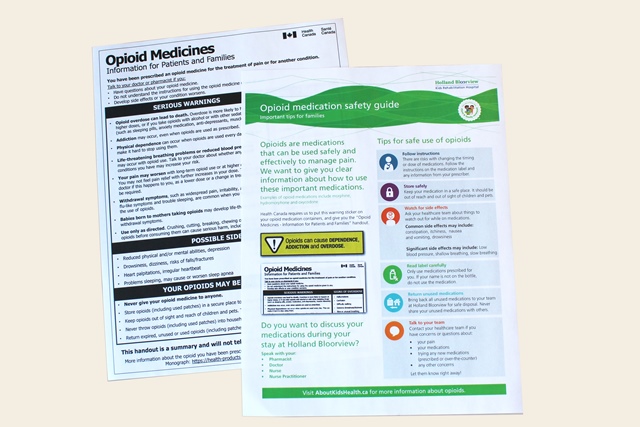
By Anthony Danial and Tamara Milicevic
Canada is in the midst of a national opioid crisis. It is a public health emergency that crosses cultural, socioeconomic, age and gender barriers. Management of this has been multi-pronged from federal and provincial actions, to regulatory bodies, hospitals, and community-driven initiatives. In 2018, Holland Bloorview Kids Rehabilitation Hospital decided to take action to provide client and family-friendly information that explained some of the potential realities of these medications to align with Canada’s national initiative. The hospital’s “Opioid medication safety guide” has been instrumental in supporting clinicians with Health Canada’s regulatory changes around dispensing these medications.
Health Canada required practice change
In an effort to provide greater caution regarding opioid use, Canada’s Food and Drug Regulations were amended in October 2018. This meant that a warning sticker and patient information handout had to be provided to patients at the time of sale in community pharmacies, with all prescription opioids. However, opioids provided during hospitalizations, under the supervision of a prescriber, are exempt from this requirement. Rehabilitation hospitals fall somewhere in between. Patients are admitted to the hospital, but often are encouraged to go home on weekend passes. When they do, the inpatient pharmacy provides all of the required medications for their time at home, including opioids.
As part of a multimodal approach to pain management, opioids are used in conjunction with non-medication strategies such as physiotherapy and psychological strategies supported by child-life and therapeutic recreation specialists. An example of this approach can be seen through Holland Bloorview’s Get Up and Go program, in partnership with The Hospital for Sick Children, for persistent pediatric pain.
For the inpatient population, opioids are most commonly used post operatively after orthopedic surgery to help with pain management during the rehabilitation process. When stable and safe to go home for weekend passes, clients at Holland Bloorview are provided with their regular medications, including pain management medications if needed.
Connecting the system through collaboration
Holland Bloorview was purposely mindful about how to incorporate the warning sticker and Health Canada patient information handout into its practice.
“Our aim was to balance safe and effective opioid use with the new regulations,” said Nathan Ho, director of pharmacy services at Holland Bloorview. “We knew that for our specialized pediatric population, the sticker and handout had to be accompanied by education and a very tailored message.”
By forming an interdisciplinary working group of pharmacists, prescribers, nurses, clinical managers and collaborative practice leads, the hospital created a client and family-friendly opioid medication safety guide. The colourful, one-page tip sheet helps contextualize the Health Canada messaging for its pediatric clients and sends the message that opioids can be used safely to help manage pain when monitored by health care providers, stored safely and taken as prescribed. This is especially important for post-operative clients whose opioids have been titrated and stabilized before the start of weekend passes.
The safety guide, written in client-friendly language and reviewed by Holland Bloorview’s health literacy team, also highlights some common side effects and who best to speak to at the hospital regarding questions or concerns. The Health Canada mandatory information handout still accompanies each of the Holland Bloorview-created safety guides.
Medication management requires having important conversations
The opioid medication safety guide is now incorporated into a standard process at Holland Bloorview where the client’s nurse reviews the safety guide and Health Canada handout, along with all of the medications that are being sent for the weekend.
Also, as part of regular patient follow up and care, the pharmacists on the inpatient units use the opioid medication safety guide to provide education to families. And on the orthopedic post-operative rehab unit, opioids are regularly discussed with families on admission, reassessed and doses adjusted and weaned prior to discharge.
“The opioid safety guide has proved to be a useful communication tool, a conversation starting point and a resource for patients and families,” said Sarah Rumbolt, clinical resource leader at Holland Bloorview. “It helps families understand how opioids can be taken safely to support their child’s rehabilitation.”
Anthony Danial is a collaborative practice leader and Tamara Milicevic is a clinical pharmacy coordinator at Holland Bloorview Kids Rehabilitation Hospital.

